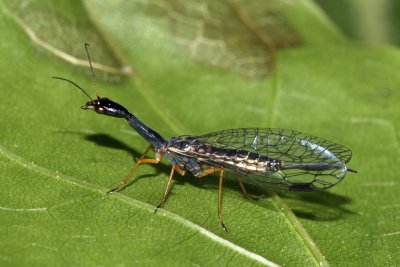News
Camel neck fly has existed for over 66 million years - a research team, with the analysed by a research team with the participation of LOEWE-TBG using genome sequencing

The so-called camel-necked fly, which is also common in Europe, was named "Insect of the Year" in 2022. Fossils show that the animal already lived at the time of the dinosaurs. As the climatic conditions on Earth changed dramatically after the Cretaceous period, only species that were able to adapt to the colder temperatures survived. Scientists from the Senckenberg Gesellschaft für Naturforschung, the University of Vienna and the LOEWE Centre for Translational Biodiversity Genomics (TBG) examined the genetic material of the black-necked camel fly (Venustoraphidia nigricollis) for a study published in the Journal of Heredity. "The data on the delicate insect was collected in the laboratory centre of the Hessian LOEWE Centre for Translational Biodiversity Genomics, which is based at the Senckenberg Gesellschaft für Naturforschung in Frankfurt am Main." This means that another of the few reference genomes of the net wing species now exists. The results will be used to understand which genetic adaptations led to the species surviving the asteroid impact and the climatic changes at the end of the Cretaceous period.
"The results now allow further research into the phylogenetic analysis of camelid flies under significantly improved conditions," reports Professor Dr Ulrike Aspöck, entomologist at the University of Vienna and the Natural History Museum Vienna and an expert on camelid flies, among other things. "They also show that there was probably still genetic exchange between different camelid fly species after the asteroid impact, because the genomes of the individual species are not completely 'sorted' according to their actual relationship. Our results are a major step forward in the study of camelid flies, but they also show that we still have a lot of research ahead of us before we really understand the ancestry of this ancient group of insects," explains Aspöck.

